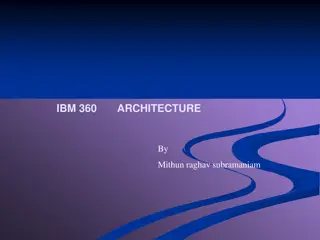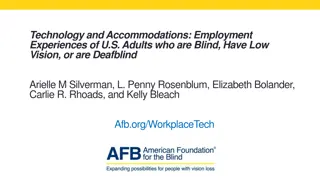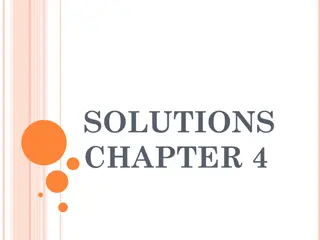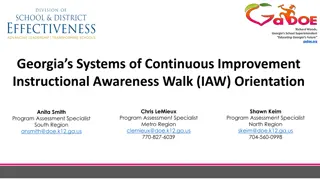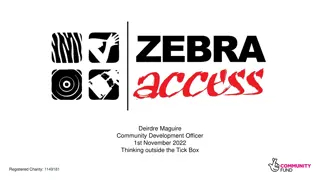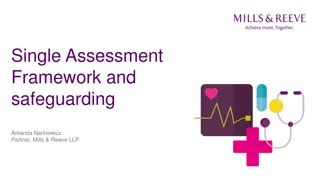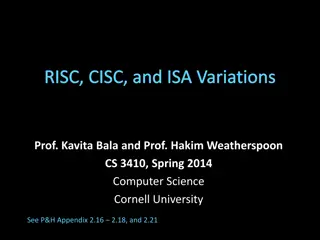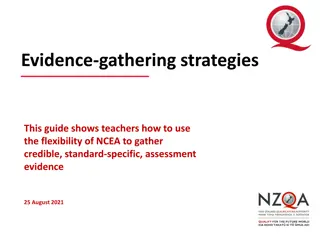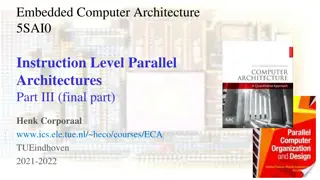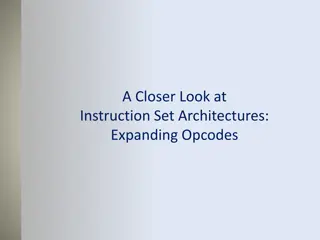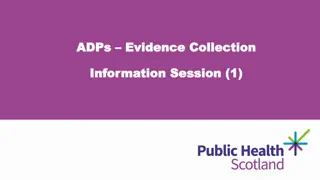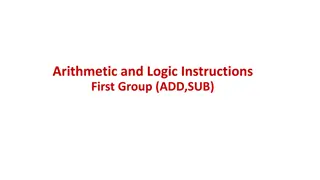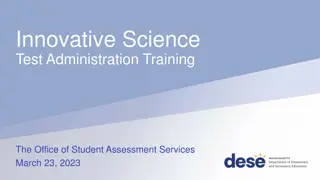Assessment and Instruction of Students Who are Deafblind: State of Evidence
This content discusses the evidence and analysis of assessment and instruction practices for students who are deafblind. It delves into the sources of evidence, the role of CEEDAR Center, and innovation configurations in identifying evidence-based practices for students with disabilities.
Download Presentation

Please find below an Image/Link to download the presentation.
The content on the website is provided AS IS for your information and personal use only. It may not be sold, licensed, or shared on other websites without obtaining consent from the author.If you encounter any issues during the download, it is possible that the publisher has removed the file from their server.
You are allowed to download the files provided on this website for personal or commercial use, subject to the condition that they are used lawfully. All files are the property of their respective owners.
The content on the website is provided AS IS for your information and personal use only. It may not be sold, licensed, or shared on other websites without obtaining consent from the author.
E N D
Presentation Transcript
+ Assessment and Instruction of Students Who are Deafblind: What is the State of our Evidence? Susan M. Bruce, Ph.D. Boston College Webinar for NCDB & DVI-DB
+Where did the evidence for this presentation come from? Analysis for the CEEDAR Center of articles published between 1967-2013 on 12 topics More in depth analysis on just communication and literacy addressed in articles appearing 1990-2015 (Bruce, Nelson, Perez, Stutzman, & Buchanan (2016). Addition of sub-topic of accommodations in assessment for Bruce, S. M., Luckner, J. L., & Ferrell, K. A. (in review of minor revision). Assessment of students with sensory disabilities: Evidence-based practices.
+What is the CEEDAR CENTER? CEEDAR stands for: Collaboration for Effective Educator Development, Assessment, and Reform Technical assistance project (federally funded) Includes commitment to identify evidence-based practices (also known as essential components ) Interested in the preparation of students with disabilities for higher education and career readiness Over course of 5 year grant, will collaborate with individuals in 20 states With state departments of education over licensing With personnel preparation programs With local school districts to support program evaluation
+Innovation Configurations Identification of evidence based practices from the existing literature (research studies, practice literature) on teaching students with disabilities Innovation configurations currently completed: two on reading (K-5 and 6-12 grades), writing, math, transition, universal design for learning, culturally responsive teaching, principal leadership, content learning with technology, use of technology in preparation of pre-service teachers, severe disabilities, sensory impairments, improving challenging behaviors of students with severe disabilities, classroom and behavior management for Tier 2 and Tier 3 strategies, English Language Learners, literacy instruction for students with multiple and severe disabilities.
+Our Analysis Process for Sensory Disabilities Innovation Configuration Examined publications about research studies and practice literature in 12 topic areas for Deaf/Hard of Hearing, Visual Impairment, and Deafblindness (1967-2013) NOTE: Calculated the level of evidence for each practice that EMERGED from analysis of the literature Thus some important practices were not identified because there were no studies and a lack of professional literature. (Ferrell, Bruce, & Luckner, 2014)
+Identifying the Level of Evidence See document: The CEEDAR Center Evidence Standards 4 levels of evidence: Strong Moderate Limited Emerging
+Defining Evidence Levels Strong: 1+ strong causal design + 1+ moderately strong or- 5 single subject design -or- 5+ correlational studies Moderate: 3+ moderately-strong causal designs -or- 3 single-subject designs (with 20+ participants and 2+ different research teams) -or- 3 correlational designs - or- 2+ meta-analyses or syntheses (with quality indicators for syntheses) Limited: At least 1 causal design study -or- 1 single- subject design study -or- 1 correlational study -or- 1 meta-analysis or synthesis (with quality indicators for syntheses) Emerging: Primarily relying on professional literature other than research studies
+Reviewing Findings: Administration Each educational team should include one member who is knowledgeable about effective assessment and instructional approaches for students who are deafblind. EMERGING Small instructional groups should be provided to ensure access, engagement, and sufficient instructional feedback. EMERGING
+Reviewing Findings: Assessment Informal assessment instruments and procedures are essential to capturing the student s abilities and needs. The sole use of formal instruments is inappropriate. EMERGING Dynamic Assessment, including child-guided Curriculum-Based Assessment
+Assessment, cont. Conduct assessments across multiple and natural environments with input from multiple adults. EMERGING Identify the strengths and needs of the family as part of early childhood assessment. EMERGING
+Assessment, cont. Conduct functional vision assessment, functional hearing assessment, and learning media assessment (including learning channels) with each student. (FVA includes assessment of cortical visual impairment.) EMERGING
+Assessment, cont. Use person centered assessment approaches to identify meaningful outcomes and necessary educational supports. EMERGING maps, MAPS, PATH, PFP Be very cautious when identifying additional disabilities in students who are deafblind. The diagnostic criteria used with other students may not be applicable. EMERGING
+Assessment, cont. Assess the visual, auditory, and tactile characteristics of each environment the student engages in (or may engage in) to: determine potential impact on student support communication programming plan appropriate adaptations and accommodations. EMERGING
+Update on Assessment Topic: Evidence-Based Accommodations Categories: Deafness Extended time, interpreting test directions, interpreting test items, reading items aloud, student signs response, and small group administration (Cawthon, 2010, Cawthon & Wurtz, 2010). Teachers select accommodations based on subject area and student s level of knowledge (Cawthon, 2011)
+Assessment Accommodations Update: Visual Impairments/Blindness Identified accommodation categories: substitutions (as in objects for pictures), enhancements (such as color or size), layout/set-up (such as how space was used), directions, and response (Zebehazy, Zigmond, & Zimmerman, 2012). -or- Presentation, time (think visual fatigue), setting, response and aids (including enlargement and braille) (Steer, Gale, & Gentle, 2007)
+Assessment Accommodations Update: VI, cont. Most commonly allowable in state assessments TIMING -administration on multiple days, extended time or frequent breaks-for fatigue and accommodations such as providing verbal descriptions). CONTEXT/SETTING- small group administration, lighting. RESPONSE-scribe, WP, brailler, recording response in booklet instead of separate sheet, use of tape recorder, e-notetaker, handwriting guide. PRESENTATION-30 accommodations listed-braille, large print, reading of test directions or test items as most common. l/3 of states did not specify allowable accommodations for students with visual impairments-allowing teachers greater flexibility (Smith & Almato, 2012)
+Accommodations Update-Deafblind Horvath, Kampfer-Bohach, & Kearns (2005): Nine students in three states: disconnect between accommodations on IEP, what was used in classroom, and what was used when conducting assessments. Stone, Cook, Latitusis & Cline (2010) (Sample included students who are deafblind-otherwise deaf sample): Need for greater consistency in enlargement of materials and need to present text in formats students are familiar with. Can we build from the evidence in DHH and VI? What assessment resources do you want to share?
+Reviewing Findings: Early Identification and Early Intervention Early identification and early intervention should be provided to reduce the developmental disadvantages posed by deafblindness. MODERATE Students who are deafblind require highly specialized and individualized services provided by collaborative teams that respect the role of family in optimizing outcomes. MODERATE
+Early Identification and Early Intervention, cont. Young students will benefit from caregiver preparation to: recognize the child s cues for interactions establish routines to elicit anticipation (think schedules) provide contingent responses. MODERATE What early intervention resources do you want to share?
+Reviewing Findings: Assistive Technology Select assistive technology based on assessment of each student. EMERGING
+Assistive Technology: Cochlear Implantation Students who are deafblind experience unique benefits, risks, and potential outcome predictors from cochlear implants. The team member with deafblind expertise should know this research. STRONG When reporting benefits (or lack of benefits) of cochlear implants, consider non-speech outcomes including improved awareness of environmental sounds or increased responsiveness. STRONG
+Reviewing Findings: Communication Communication development and social interactions should be emphasized every day in the context of natural environments. LIMITED Communication programming should address forms/modes, intents/functions, content, context, and pragmatics. EMERGING Apply child-guided approaches to support communication development and different types of dialogues. LIMITED
+Communication, cont. Apply systematic approaches to increase the rate and variety of communicative intents/functions expressed. MODERATE Implement individualized communication programming that reflects knowledge of the student s level of communication. EMERGING Communication Matrix Improve adult communication partner skills through systematic demonstration and modeling. LIMITED
+Communication, cont. Tangible representations/symbols are a critical form of communication for prelinguistic students who are deafblind. MODERATE
+Reviewing Findings: Literacy An expanded view of literacy (that goes beyond traditional reading and writing) is required to address the needs of students who are deafblind and prelinguistic. EMERGING Daily schedules/anticipation shelves as a literacy lesson. Provide a literacy rich environment with hands on experiences to conceptually ground the literacy experiences. EMERGING
+Related Publications on Evidence- Based Communication & Literacy Practices 2014-2016 Bruce & Borders (2015) situates findings largely from CEEDAR review in their appropriate theoretical groundings: Developmental, Behavioral, Social-Interactions (a theory from Deaf education that applies well to approaches in deafblindness). Bruce & Borders (2015) presents the 5 primary CEEDAR findings in communication with associated references.
+Update, cont. Bruce, Nelson, Perez Stutzman, & Barnhill (2016) provides much greater detail on the research designs and findings on communication-and only addresses studies 1990-2015. So, if you read something in CEEDAR doc and want to know more detail, this is a good resource. Framed all findings using the four aspects of communication: Form (mode), Function, Content, & Context Included qualitative studies that were not eligible for CEEDAR review. What communication and literacy resources would you like to share? (Please see Communication Bill of Rights )
+Reviewing Findings: Social-Emotional Identify the purpose fulfilled by unacceptable behaviors. EMERGING (Functional Behavioral Assessment-FBA) Teach socially acceptable ways of communicating and other replacement behaviors for unacceptable behaviors. EMERGING (As reflected in Positive Behavior Support Plans) Knowledge of the child s etiology and the impact of deafblindness is critical to assessment and to planning individualized positive behavior support plans. MODERATE
+Social-Emotional, cont. Apply behavioral principles to reduce or eliminate stereotypies, self-injurious behaviors, and aggression toward others. MODERATE Appropriate changes in the curriculum, environment, and the nature of adult responses can support positive change in behavior in children who are deafblind. EMERGING Any resources you d like to share?
+Reviewing Findings: Mathematics Use consistent wording for mathematical symbols and operations. EMERGING When preparing to teach each math lesson, consider: student s experiential knowledge vocabulary demands of lesson need to modify content need for manipulatives to support understanding need for adaptations to improve access and participation. EMERGING
+Mathematics, cont. Provide instruction on the use of specialized mathematics equipment and specialized approaches, such as the abacus or mental math. EMERGING Any resources to share?
+Reviewing Findings: Science When preparing to teach each lesson, consider: student s experiential knowledge vocabulary demands of the lesson the need for modification of content adaptations and accommodations non-visual means of presentation. EMERGING Any resources to share?
+Reviewing Findings: Life Skills Improve daily living skills through systematic instruction that includes task analysis and the application of behavioral principles (such as graduated guidance). STRONG Any resources to share?
+Life Skills: Orientation & Mobility With the guidance of the Certified Orientation and Mobility Specialist (COMS), improve O & M skills through systematic instruction in the context of structured activities that are desirable and functional. LIMITED O & M instruction for students who are deafblind must be modified (from what is offered to students who are visually impaired) by considering The impact of deafblindness Potential balance issues Unique communication needs Length or number of sessions (due to sequential communication when traveling). EMERGING Any resources to share?
+Reviewing Findings: Transition Vocational experiences during secondary education increase the likelihood of post-school employment. EMERGING An interagency approach to Personal Futures Planning is critical to: capturing the strengths and needs of the individual planning natural and paid supports for all aspects of adult living. EMERGING Any resources to share?
+Reviewing Findings: Placement/Inclusion Collaborative teaming is essential to the successful inclusion of students who are deafblind. EMERGING Paraprofessionals with specialized preparation or interveners are crucial to the success of children who are deafblind. EMERGING Adults must create opportunities for reciprocal interactions between students who are deafblind and their peers and provide direction instruction about how to interact. EMERGING
+Placement/Inclusion/Engagement: Universal Design for Learning The principles of universal design for learning (UDL) can be applied to enhance access, participation, and engagement. EMERGING The three UDL principles (to be applied) are: Multiple means of representation (think receptive forms/modes) Multiple means of action and expression (think expressive forms/modes) Multiple means of engagement (think cues, environment ). EMERGING
+What can we do with these findings? For evaluation of syllabi in personnel preparation For program evaluation (at individual student level) In advocacy of individualized programming elements, team members, approaches, strategies To plan inservice efforts to address staff areas of need
+Summary of Highest Need Areas for Future Research Math Science Literacy (especially reading and writing) Transition O & M We need higher levels of evidence for assessment (including identification of categories of accommodations and informal assessment), administration, more research on assistive technology (other than CI) Develop research evidence for essential components not addressed in this analysis
+ References Please see the Innovation Configuration on Sensory Disabilities to see the full list of references (across the three disability areas). Easiest to locate by: Google: CEEDAR Center-then click on Innovation Configuration heading within GOOGLE-as opposed to going to the CEEDAR site and locating it.
+References for updated topics on accommodations, communication, literacy (not included in CEEDAR review) Bruce, S. M., & Borders, C. (2015). Communication and language in learners who are deaf and hard of hearing with disabilities: Theory, Research, and Practice. American Annals of the Deaf, 160, 368-384. Bruce, S. M., Nelson, C., Perez, A., Stutzman, B., & Barnhill, B. A. (2016). The state of research on communication and literacy in deafbindness. American Annals of the Deaf. Bruce, S. M., Luckner, J. L., & Ferrell, K. A. (in review of minor revision). Assessment of students with sensory disabilities: Evidence-based practices.
+ Cawthon (2010). Science and evidence of success: Two emerging issues in assessment accommodations for students who are deaf or hard of hearing. Journal of Deaf Studies and Deaf Education, 15, 185-203. Cawthon & Wurtz (2010). Predictors of assessment accommodations use for students who are deaf or hard of hearing. Journal of Educational Research & Policy Studies, 10, 17-34. Cawthon (2011). Making decisions about assessment practices for students who are deaf or hard of hearing. Remedial and Special Education, 32,4-21.
+ Horvath, L. S., Kampfer-Bohach, S., & Kearns, J. F. (2005). The use of accommodations among students with deafblindness in large- scale assessment systems. Journal of Disability Policy Studies, 16,177-187. Smith, D. W., & Amato, S. (2012). Sythesis of available accommodations for students with visual impairments on standardized assessments. Journal of Visual Impairment & Blindness, 106, 299-304. Steer, M., Gale, G., & Gentle, F. (2007). A taxonomy of assessment accommodations for students with vision impairments in Australian schools. The British Journal of Visual Impairment, 25, 169-177. Note: Addresses U.S. schooling too.
+ Stone, E., Cook, L., Laitusis, C. C. & Cline, F. (2010). Using differential item functioning to investigate the impact of testing accommodations on an English-Language Arts assessment for students who are blind or visually impaired. Applied Measurement in Education, 23, 132-152. Zebehazy, K. T., Zigmond, N., & Zimmerman, G. J. (2012). Performance measurement and accommodation: Students with visual impairments on Pennsylvania s alternative assessment. Journal of Visual Impairment & Blindness, 106, 17- 30. All images are from Google Images
+Questions and Answers If your question requires a longer conversation than time allows today, please contact me: susan.bruce@bc.edu 617-552-4239



